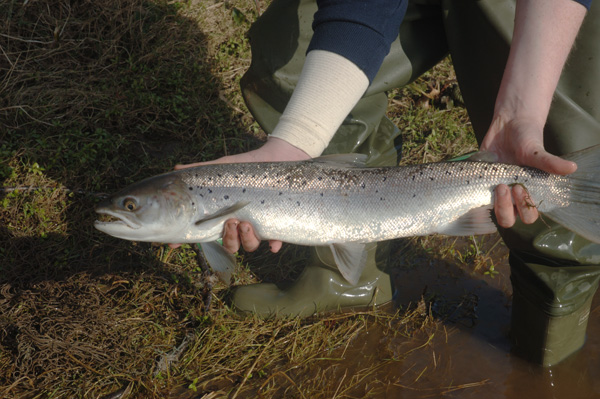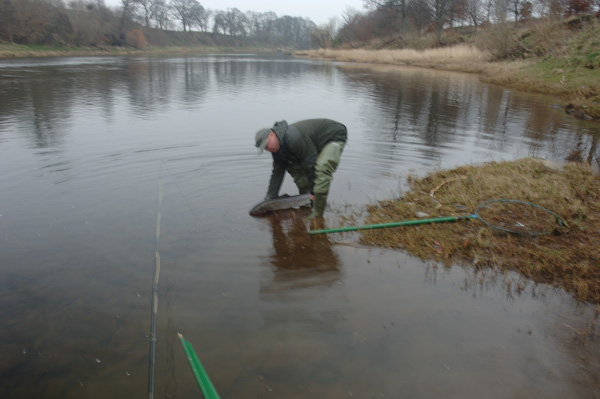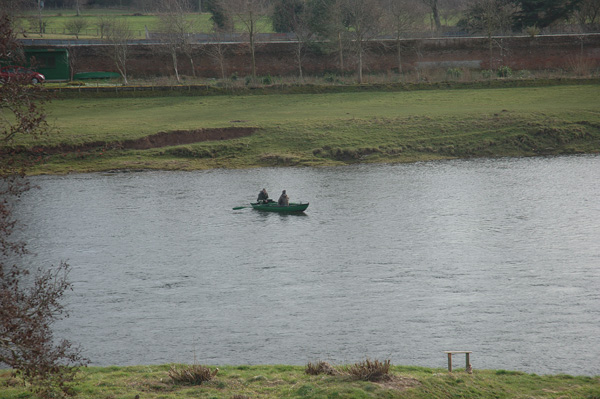
Spring Salmon Fishing on the River Tweed
An article by Mark Roberts.
I was sat at the tying desk last Friday when the phone rang unexpectedly. A good fishing friend was on the line explaining that due to family circumstances he was unable to enjoy the first three days of a weeks fishing he had booked on the River Tweed from that following Monday.
I sat very still with my legs crossed for what seemed an age praying that his next words would be ‘Are you available to go in my place?’ Just as I was thinking it wasn’t going to happen those magic words were spoken.
I could have jumped down the phone and kissed him there and then. Details were given and I was told that the other two on the beat were fine fellows of distinction. Then he told me their names and was relieved to know one of them was an old friend.
Sunday morning came and I made the 7 1/2 hour journey by car from one end of the country to the border town of Coldstream home of the guards.
As I crossed the river to enter the town my heart was jumping about in my mouth. A quick glance over the bridge wall had me all of a quiver. It appeared to be at a good fishing height and it was clear. The beat we were to fish was the Lower Birgham beat about 2 miles upstream of Coldstream.
The hotel where we were staying was the Castle Hotel in Coldstream and as I entered the door I was greeted by two old friends and one new one. Many beers were enjoyed in the first few hours. Flies were viewed and the excitement continued to grow. Dinner was eaten and all the talk was of salmon won and lost in the years gone by.
Now, salmon fishing means many things to many people but for me, it cannot be a competitive occupation as that can unsettle the soul. The truth is it is about good company, good spirits and most of all about having fun. I was so fortunate that my angling partners for the week were of the same view. When you all have different views it can mean that the day’s fishing to follow may be longer than you wished.
With thick heads, we arrived at the fishing hut at 9 am sharp ready for a briefing and instruction from the head boatman. Everything was arranged and advice was freely given. The beat was split into three with two being fished by boat and a third from the bank.
I was to fish the top beat from the right-hand bank to start for the first half of the day and then I would rotate to the lower beat to fish with the senior boatman in the afternoon. The water looked great and really fishy. I could see kelts flashing and leaping about all morning but all my efforts were in vain. I fished a Rio Mid Spey to start with a very fast sink tip and short 4′ leader and a heavy Gold Willie Gun 1″ 1/4 copper tube to start on the advice of the Ghillie. You soon learn that what the ghillie or boatmen say should be listened to if you want them to help you get the fish.
The top of the beat started at a weir and had great streams running through it. I fished down well back from the bank in the cold morning air as instructed and saw an occasional fish move only feet from the edge of the bank.
Once through I fished the next run down and watch as the current brought the fly around. I felt a short bump on the rod tip and the fly was drawn a fraction then released.
My heart was pounding. It had been a long winter and the previous season had been a disaster for me. To feel a fish on the first run through was really exciting. I could see the boat below me moving slowly through the beat and I saw fish jumping about to the left and right of it. They looked silverfish but you could tell they were kelts because of the leap and splash they made. I was searching hard for the telltale head and tail purpose of a running fresh fish.
The morning shot by so fast it was hard to believe that the mandatory hour stop for lunch was upon us. Over Tea and sandwiches, the postmortem revealed one take on the lower beat and a kelt was landed. Alas, no sign of a fresh fish. Yet!
I was in the boat in the afternoon and I decided to put on a large Yellow and Black Waddington with a gold body. This fly would not fish as deep as the tube but I had faith that in the clear water it would be easily seen.
You do not overhead cast in the boat only double-spey in the downstream wind so as to keep you and more importantly the boatman safe. Only a madman would upset the Ghillie. Third cast and I had a pull. My heart was thumping. Then another followed by a long draw. I lifted the rod and the satisfying bump, bump of a salmon hooked was transmitted by the rod tip. The boatman started to row back to shore and it was off. I thought a few things most of which I cannot print but back to the casting I went.
The next hour brought a few slow pulls on the rod but no real takes. Then I saw olives coming down the river. I have always felt that when you get olives hatching there is always a chance of a fish taking and I said so to the Ghillie. His reply ‘Do you now’ was met with a savage take and a run. Fish on.
This time it stayed on and following a short battle it was netted. I saw a sliver flank and both I and the boatman thought we had a springer until the net was moved of the fish and a well-mended kelt was returned safely to the water. Off we went again and, on the second cast, a second smaller fish came to the net. This again was a kelt but it was really good to have fish on again after so long. My confidence was up and we knew there was a good chance of a springer.
The following day found the river rising and it did so throughout the day. Up by 5 inches by home time. I never feel very confident in a rising river and that self-fulfilling prophecy was proved again.
My last day came and I was on the boat all day. I wanted to try some new patterns tied on the Frodin flat cone head style. I had tied them on 22mm brass tubes. Well, it worked and I landed a fish by 10 a.m. Unfortunately, it was again a kelt.
The last cast before dinner and the fly worked again and another kelt was netted. This again was closely viewed by the boatman for signs of being a springer. As you can see by the photo below it was well mended and bright as a button.
I finished the day and my trip without a springer but my new fishing friend John had a cracker of 7lbs that morning and I was as pleased as if I had caught it myself. The fish was returned under the rules of the river. Those are that you can kill your second fresh fish but must return the first. Sounds like good common sense to me.
The River Tweed is a fantastic river and, if you get the chance fish it, do not be daunted by the big flows as it is full of fish and they lie everywhere.
All I have to do now is convince She-Who-Must-Be-Obeyed to let me go again.










